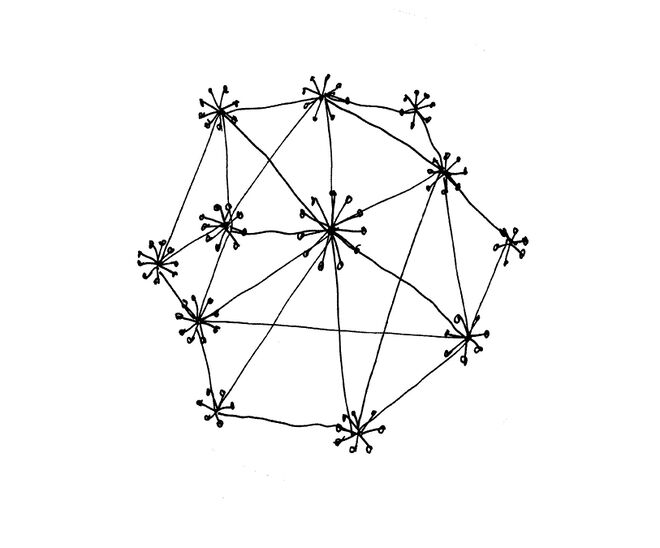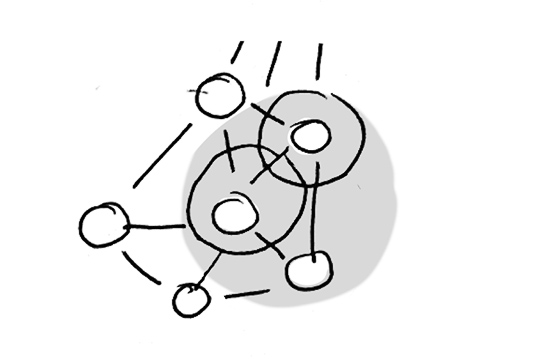18.2. Polycentric Governance
Aus Pattern Language Wiki
(Weitergeleitet von .../Polycentric Governance)
The governance of Polycentric Region and all of their components also needs a corresponding polycentric (many-centered) structure…
Problem-statement: Most of the problems of cities and towns are embedded within inter-connected networks of partly overlapping sub-systems. To be effective, the governance systems of cities and towns need a similar structure.
Discussion: It is crucial for each unit of governance to see itself as embedded within a larger cooperative system which is partly formal, and partly informal. The business of governance of public spaces is thus a matter of continuously negotiating agreements, identifying and resolving problems, working through conflicts (including with other units of governance) and promoting the best interest of the public realm as much as is possible within the constraints of the moment. This is the nature of “polycentric governance.”
The idea of polycentric governance was developed most thoroughly by the political economist Eleanor Ostrom1, who described a series of partly overlapping institutions (including governments, businesses, NGOs and individuals) working within a cooperative structure defined by agreements and basic rules. The concept goes back at least to the work of Michael Polanyi, and, as discussed more recently by Aligicka and Tarko2, is defined as “a social system of many decision centers having limited and autonomous prerogatives and operating under an overarching set of rules”. These rules include formal laws, contractual agreements, and informal or even tacit agreements between the polycentric entities.
Consider for example a restaurant with a sidewalk café. The restaurant does not own the sidewalk area, and in fact may not even own its building. It may have a lease with the building owner, and a permit with the city authority controlling the sidewalk. At the same time, the city may have authority over the cleanliness of the restaurant, as well as the fire safety of the building and its owner. In addition, a business association may have less formal control over the kind of signage and street furniture allowed on the sidewalk café. Finally, restaurant staff may have informal control over people who use the seating area, with the right to ask non-customers to leave — even though the staff does not own the sidewalk, does not own the building, and may not own the restaurant! Many overlapping layers of formal and informal governance come together in a network of relationships.
It is important therefore to respect and support these multiple levels of governance. Too often, however, centralized institutions (especially governments) suppress polycentric governance networks, often because they are simply more difficult to manage. This tendency must be resisted, in order to tap the superior problem-solving power of self-organizing and distributed networks.
Therefore:
Structure the governance of place in your city, town or neighborhood as a series of many overlapping formal and informal institutions, a system of “polycentric governance.” Various institutions will have formal control over specific defined parts of a structure, but many other institutions will have overlapping and informal controls. Work to cooperate with these various entities from your own position or, very often, multiple positions.
Recognize and support the least structured forms of place governance, including Informal Stewardship. Assure that Public-Private Place Management is balanced, and does not serve the interest of private over public interests.
¹ See Ostrom, E. (2010). Beyond markets and states: Polycentric governance of complex economic systems. American Economic Review, 100(3), 641-72.
² See Aligika, P. and Tarko, V. (2012). Polycentricity: From Polanyi to Ostrom, and Beyond. Governance: An International Journal of Policy, Administration, and Institutions, 25(2), April 2012 (pp. 237–262).
Mehaffy, M. et al. (2020). POLYCENTRIC GOVERNANCE (pattern). In A New Pattern Language for Growing Regions. The Dalles: Sustasis Press. Available at https://pattern-language.wiki/.../Polycentric_Governance
SECTION I:
PATTERNS OF SCALE
1. REGIONAL PATTERNS
Define the large-scale spatial organization…
1.4. 400M THROUGH STREET NETWORK
2. URBAN PATTERNS
Establish essential urban characteristics…
3. STREET PATTERNS
Identify and allocate street types…
4. NEIGHBORHOOD PATTERNS
Define neighborhood-scale elements…
5. SPECIAL USE PATTERNS
Integrate unique urban elements with care…
6. PUBLIC SPACE PATTERNS
Establish the character of the crucial public realm…
7. BLOCK AND PLOT PATTERNS
Lay out the detailed structure of property lines…
8. STREETSCAPE PATTERNS
Configure the street as a welcoming place…
9. BUILDING PATTERNS
Lay out appropriate urban buildings…
10. BUILDING EDGE PATTERNS
Create interior and exterior connectivity…
10.1. INDOOR-OUTDOOR AMBIGUITY
SECTION II:
PATTERNS OF MULTIPLE SCALE
11. GEOMETRIC PATTERNS
Build in coherent geometries at all scales…
11.2. SMALL GROUPS OF ELEMENTS
12. AFFORDANCE PATTERNS
Build in user capacity to shape the environment…
13. RETROFIT PATTERNS
Revitalize and improve existing urban assets …
14. INFORMAL GROWTH PATTERNS
Accommodate “bottom-up” urban growth…
15. CONSTRUCTION PATTERNS
Use the building process to enrich the result…
SECTION III:
PATTERNS OF PROCESS
16. IMPLEMENTATION TOOL PATTERNS
Use tools to achieve successful results…
16.2. ENTITLEMENT STREAMLINING
16.3. NEIGHBORHOOD PLANNING CENTER
17. PROJECT ECONOMICS PATTERNS
Create flows of money that support urban quality…
17.4. ECONOMIES OF PLACE AND DIFFERENTIATION
18. PLACE GOVERNANCE PATTERNS
Processes for making and managing places…
18.3. PUBLIC-PRIVATE PLACE MANAGEMENT
19. AFFORDABILITY PATTERNS
Build in affordability for all incomes…
19.1. INTEGRATED AFFORDABILITY
20. NEW TECHNOLOGY PATTERNS
Integrate new systems without damaging old ones…
20.2. RESPONSIVE TRANSPORTATION NETWORK COMPANY

